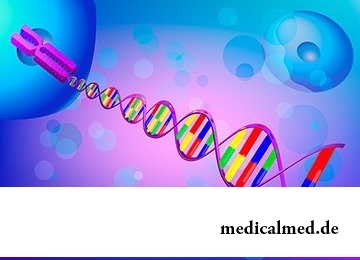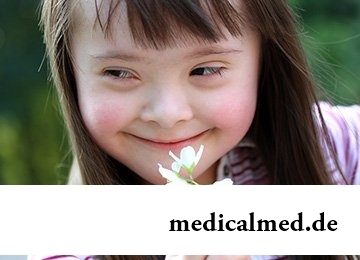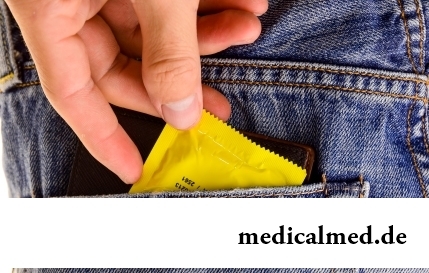





Patau's syndrome
 Patau's syndrome, or syndrome of a trisomy of a chromosome 13, represents a serious genetic illness at which in a karyotype (chromosomal complement) there is an additional copy of a chromosome 13.
Patau's syndrome, or syndrome of a trisomy of a chromosome 13, represents a serious genetic illness at which in a karyotype (chromosomal complement) there is an additional copy of a chromosome 13.
About 1 of 7000-10000 babies is born with such defect. Genovariation occurs at boys and girls equally.
Reasons of a syndrome of Patau
It is established that, in most cases, trebling of the 13th chromosome is the reason of a syndrome of Patau, that is in each cell there are not two (norm), and three copies of the thirteenth chromosome. Seldom or never only a part of cells of an organism has the additional copy. It is a so-called mosaic syndrome of Patau.
One more cause of illness – a translocation (reorganization) of chromosomes when part 13 of a chromosome to or directly at the time of conception becomes attached to other nonhomologous chromosome. As a result of such reorganization patients along with two copies of the 13th chromosome have additional material from it which is connected to other chromosome. There is a partial trisomy of the 13th chromosome at which physical signs of a syndrome differ from a typical clinical picture a little.
As a rule, Patau's syndrome is not inherited, and arises accidentally in the course of formation of spermatozoa and ova. If at cell fission there is a mistake which is called not discrepancy, it leads to emergence of sex cells with the wrong chromosome number. When similar atypical spermatozoa and ova are involved in genetic structure of the child, he receives an additional 13th chromosome in all cells of an organism. Mosaicism of this syndrome is also not inherited and arises as accidental failure at cell fission at an initial stage of development of a germ.
The disease can be inherited in case of the balanced translocation when the healthy person bears the changed genetic material between the thirteenth and other chromosomes. The persons which are carriers enter into risk group on the birth of children with this genetic disease though and have no signs of a trisomy of a chromosome 13.
Clinical picture
All children with Patau's syndrome have heavy inborn defects of a skull, brain, internals and a musculoskeletal system.
Treat characteristic symptoms of a disease:
- Inadequately developed bones of a brain and facial skull;
- Trigonotsefaliya (strong narrowing of a skull in a frontal part and sharp expansion in occipital);
- The changed structure of brushes and feet;
- Symmetric polydactylism (it is possible, but arises not always);
- Narrowing of palpebral fissures and close arrangement of eye-sockets;
- Shortening of a neck;
- Lack of an iris of the eye or eyeglobe (sometimes);
- Deformation and wrong arrangement of auricles;
- Crevice of a lip and sky;
- Sticking of a nose bridge, etc.
At babies with Patau's syndrome the alimentary system and the main brain structures of TsNS is underdeveloped. Heavy malformations are observed in cardiovascular system – defects of cordial partitions and large blood vessels. The urinogenital system suffers: cryptorchism (not omission of testicles), two-horned uterus, hypoplasia of external genitals. Sometimes there is no back wall of an urethra, and kidneys are strongly increased in sizes and have cysts in the bast layer.
Diagnosis of a syndrome of Patau
Prenatal diagnosis of all chromosomal diseases including Patau's syndrome, it is identical. The first stage of screening includes an ultrasonography research and definition of biochemical markers (PAPP-A, beta HGCh, etc.). On the basis of the obtained data the risk of the birth of the child is calculated with a genetic disease.
Offer pregnant women who got into risk group the following methods of invasive prenatal diagnosis:
- 8-12 weeks – a biopsy ворсин chorion (capture of a sample of cells ворсин and their check on existence of defects);
- 14-18 weeks – amniocentesis (a puncture of an amniotic cover for receiving amniotic waters for the purpose of their subsequent laboratory research);
- 20 weeks and more – кордоцентез (the analysis of umbilical blood).
In the received materials search of a trisomy in the 13th chromosome by the KF-PTsR method (quantitative fluorescent polymerase chain reaction) or karyotyping with differential coloring of chromosomes is carried out.
If prenatal diagnosis of a syndrome of Patau was not carried out, it is possible to reveal chromosomal anomaly on the basis of clinical signs. However the analysis on definition of chromosomal complement of the newborn is necessary for confirmation of the diagnosis.
 Babies with the established or estimated hereditary disease need careful comprehensive examination which is directed to detection of heavy malformations (a neyrosonografiya, ultrasonography of kidneys and abdominal organs, an echocardiography, etc.).
Babies with the established or estimated hereditary disease need careful comprehensive examination which is directed to detection of heavy malformations (a neyrosonografiya, ultrasonography of kidneys and abdominal organs, an echocardiography, etc.).
Treatment and forecast
Specific treatment of a syndrome of Patau, for obvious reasons (failures in the genetic device), no. For correction of inborn defects carry out operative measures, and for maintenance of normal functioning of systems and bodies appoint fortifying therapy (polyvitaminic complexes, dietary supplements and drugs for increase in level of immunity).
The forecast at this disease adverse. The bulk of children with Patau's syndrome dies in the first months of life, only sometimes living about one year. It is explained by high severity of inborn defects of internals. In rare instances patients live 3-5 years, remaining at the same time full disabled people and having sharp disturbances in psychomotor development.
At regular visit of a sunbed the chance to develop a carcinoma cutaneum increases by 60%.

At this plant there are a lot of names: tuberiferous sunflower, Jerusalem artichoke, solar root, earth pear. Contrary to spread...
Section: Articles about health
The nature does not stand stagnation and monotony. It is known that tissues of a human body atrophy if do not receive necessary loadings. It fully belongs also to a cerebral cortex: when it is not given full-time job, it begins to function worse. In резуль...
Section: Articles about health
The next flu epidemic leads to the next panic, from year to year we give in on these manipulations: professionally alarming voice of the announcer in news, reports with calculation of the died patients, an interview with people in white dressing gowns and advertizing of anti-influenza means of different degree of inefficiency. All this reminds the Hollywood movies of epidemics threatening to destroy our planet. However, there is also one more similarity to cinema: everything comes to an end well. So, how to deal with the events, not in...
Section: Articles about health
Color of plants is caused by presence at them of certain chemical compounds. Let's talk that various colors mean vegetable...
Section: Articles about health
Doctors claim that the people not so familiar with a dorsodynia occur among adult Russians very seldom. At the same time the vast majority of the patients who are periodically testing this indisposition do not hurry to ask for medical care at all. With one St...
Section: Articles about health
Life activity of one-celled fungi of the sort Candida, related to yeast is a proximate cause of development of candidiasis (milkwoman). Normal these microorganisms are a part of the microflora living in an oral cavity and intestines of most of people and also in a female genital tract. The pathological phenomena are observed when fungi begin to breed too violently. At the same time there is an inflammatory process affecting mucous membranes and which is shown very nepr...
Section: Articles about health
Antibiotics - - it is possible to call the chemical compounds suppressing growth of bacteria the break in the field of medicine which allowed to save persons...
Section: Articles about health
The hysteromyoma is diagnosed more than at a third of women 35 years are more senior. This high-quality new growth which at early stages successfully resolves by means of medicines. It is necessary to resort to an operative measure only in those a case...
Section: Articles about health
Many of us, probably, noticed more than once that from intellectual loadings at some point the brain as though "overheats" and "assimilation" of information is strongly slowed down. Especially this problem urgent for persons of age becomes more senior than fifty years. "Already badly I think", "the head will burst now", "memory as if is disconnected" - here that wants to be told at the time of information overload....
Section: Articles about health
One of the useful properties presented to the person by the nature is ability to feel fear. This ability is called a signal...
Section: Articles about health
What will only not be thought up by persons interested to have a beautiful figure. Here the last innovation – for weight loss needs to be eaten greasy food. Let's understand whether there is at a fatty diet common sense....
Section: Slideshow
The person, as well as all other beings living on our planet feels weather changing. It is the normal meteosensitivity which is not causing to healthy people of special troubles. Meteodependence, on the contrary, is the morbid condition which is characterized by an exacerbation of chronic illnesses at change of air temperature, differences of atmospheric pressure, wind strengthening, magnetic storms and other "surprises" on which the nature is so generous. The people suffering from meteodependence have to з...
Section: Articles about health
You are office worker, the driver, the fan of winter sports or do not think of life without bicycle? You conduct a slow-moving image жизн...
Section: Articles about health
Contrary to popular belief, the multiple sclerosis (MS) is not connected neither with sclerous changes of walls of vessels, nor with age forgetfulness and problems with concentration of attention. This disease has the autoimmune nature. Pathological process of a vyrazh...
Section: Articles about health
Popular joke that there are no healthy people, and is nedoobsledovanny, most of us considers an honest truth, continually it is necessary to hear that all of us are sick hardly from a school bench. It is hard to say whether so it actually because too often people are treated for nonexistent diseases, and sometimes call a disease what is something another. Sometimes in it the doctors of old school making diagnoses which are cancelled long ago – medicine still unless are guilty...
Section: Articles about health
All got used long ago that, having addressed the plastic surgeon, it is possible to modify natural parameters of a figure or to reduce...
Section: Articles about health
From the failure of work of immune system which is shown in the form of an allergy, statistically, more than 40% of the population of the globe suffer. In most cases pathological reactions cause the substances which are contained in food stuffs, hair of animals, medicines...
Section: Articles about health
All diseases from nerves – in this joke a big element of truth, are said by doctors. Constant stresses lead to decrease in protective forces of an organism, and it becomes vulnerable for a set of diseases. It is wrong to think that the stress is a problem of the present. Life of people and hundred, and one thousand years ago also abounded with problems therefore need of a relaxation understood in ancient times – to some techniques more than one thousand years. The person needs knowledge of how it is possible to relax, this knowledge пригод...
Section: Articles about health
Today about 30 diseases, sexually transmitted are known. To wide circulation of these illnesses extremely with...
Section: Articles about health
Impossibility to conceive the child – a trouble of many Russian families. During quite long time was considered that main "culprits" of troubles such are women. Modern physicians claim that the situation is different: about a half of failures at...
Section: Articles about health
Olive oil – the product capable to make a powerful contribution to health of the person if it includes it in the diet. The rich vitamin composition of oil does it by a product number one from many diseases including from deadly. Only two tablespoons of oil from olives in day prevent emergence of diseases of vessels and heart, cancer, problems with digestion, presenilation, a depression and many other illnesses which treatment would demand a lot of time and forces. Let's consider on...
Section: Articles about health
New year, wedding, birthday, office party – an occasion to drink at the Russian person will always be. How to reduce a negative impact...
Section: Articles about health
Tea is loved and use almost everything. This drink has tonic properties, contains the tannins capable to suppress activity of causative organisms. Recently great popularity was gained by teas with vegetable additives. Лечеб...
Section: Articles about health
Dietary supplements (dietary supplements) for the last decades were so thoroughly included into our life that, apparently, it is already impossible to find the person who at least once did not try them. At the same time, most of our compatriots have a vague idea of what dietary supplements as they affect a human body consist of and what differ from the real medicines in. Let's try to understand these questions, and at the same time and to understand, such additives are how necessary for us....
Section: Articles about health
We live during an advertizing era. Daily each person receives a solid portion of persuasive councils about what to eat to be здо...
Section: Articles about health
Quite large number of people adheres to the principles of vegetarian food. But how to be if in a family of vegetarians there are children? Whether it is possible to eat also it the same as to parents, or after all the children's organism is not adapted for the use only раст...
Section: Articles about health
Smack in a mouth can arise in the natural way – as a result of lack of morning hygiene or reception of the corresponding food. However in certain cases its existence is a sign of certain pathologies, and allows to reveal an illness at an early stage. Depending on character of aftertaste – acid, salty, bitter, sweet – distinguish also diseases which accompany it....
Section: Articles about health
